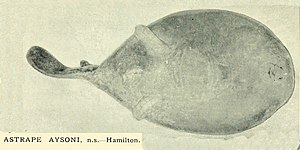Typhlon brand aysoni
| Typhlon brand aysoni | ||||||||||||
|---|---|---|---|---|---|---|---|---|---|---|---|---|

Photo of the ventral side of Typhlonarke aysoni from the first description |
||||||||||||
| Systematics | ||||||||||||
|
||||||||||||
| Scientific name of the genus | ||||||||||||
| Typhlon brand | ||||||||||||
| Waite , 1909 | ||||||||||||
| Scientific name of the species | ||||||||||||
| Typhlon brand aysoni | ||||||||||||
| ( Hamilton , 1902) |
Typhlonarke aysoni is a species of ray from the family of sleeper rays (Narkidae) and the only representative of the genus Typhlonarke . The ray species occurs on the east coast of the South Island of New Zealand .
features
Typhlonarke aysoni is 45 centimeters long. There are also reports of 90 cm long specimens, but these are considered implausible. The body disc is approximately round to oval, the tail is very short. On the back, the fish are dark brown or greenish in color, darker in the back than in the front. The edges of the body disc are sometimes a little lighter. The ventral side of Typhlonarke aysoni is almost a monochrome brownish color, the pelvic region and the area around the mouth are lighter. The eyes are not visible from the outside and are completely overgrown by skin. The injection holes are round and surrounded by a low papilla rim. The mouth and the small, round nostrils can be stretched out like a tube. The mouth is surrounded by thick lips. The teeth are in 10 to 12 rows in both jaws. The teeth are small and wide. They have triangular tips. The pelvic fins are in two parts. The caudal fin is long, narrow and rounded at the end. It is significantly larger than the dorsal fin, which is close to the caudal fin. The clusters of males are short and flat and usually do not extend beyond the posterior edge of the disc.
Way of life
Typhlonarke aysoni is relatively rare and lives close to the coast on soft soils on the continental shelf at depths of 50 to 900 meters, most records are from depths of 300 to 400 meters. The ovoviviparous fish get up to 11, at birth 9 to 10 cm long young animals per litter. The rays reach sexual maturity with a length of 35 to 40 cm.
Systematics
The ray species was first scientifically described in 1902 by the New Zealand biologist Augustus Hamilton as Astrape aysoni . As Terra typica was the Foveaux Strait , a strait between the South Island and Stewart Iceland stated. Today the species belongs to the genus Typhlonarke , which was introduced in 1909 by the Australian zoologist Edgar Ravenswood Waite . In Typhlonarke tarakea described in 1929 by William John Phillipps, it is probably a synonym description of poorly preserved specimens of aysoni Typhlonarke .
Individual evidence
- ↑ a b c d Last, PR, White, WT, Carvalho, MR, Séret, B., Stehmann, M. & Naylor, GJP Rays of the World. CSIRO Publishing: Melbourne. ISBN 9780643109131 . Page 181.
- ↑ Typhlon brand aysoni on Fishbase.org (English)
- ↑ Typhlon brand in the Catalog of Fishes (English)
Web links
- Typhlon brand aysoni on Fishbase.org (English)